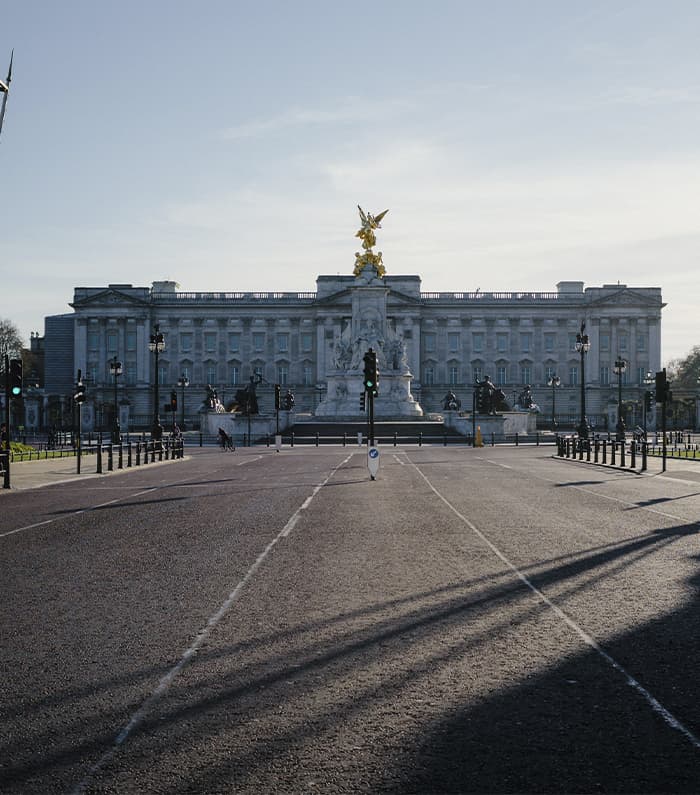Buckingham Palace

Both Queen Elizabeth II prefers this palace to other buildings in London, and Queen Victoria (though one lives in it for real, and the other is nearby as a monument). One look at the residence of the British monarchs, causes bewilderment: owning such splendor, the Duke of Buckingham could have asked Anne of Austria for a gift more modest than pendants. But, firstly, the palace was more modest in those days, and secondly, Dumas made it all up.
It is already clear that the building was not intended for the kings and queens of Great Britain, but for the eponymous duke, for whom the palace walls were built at the dawn of the 18th century. Fifty-nine years later, the building was bought by George the Third, who was not satisfied with St James’s residence for two reasons: cramped and squalid (at least, so thought the monarch).
Another 75 years passed and the authors of the Alupka Palace (Nash and Blore) “shuffled” by analogy with Buckingham House a few more buildings, which in the complex with the prototype formed a huge square courtyard.
When Queen Victoria ascended the throne, which happened in 1837, the palace was declared the official residence of the British monarchy. At this time, the infrastructure was being improved: an additional annexe appeared, the front entrance moved to the Oratory Corner of Hyde Park (represented by the Marble Arch). The main palace gate was preceded by a monument to Queen Victoria herself. It cost the treasury seven hundred thousand pounds sterling (Carrara marble isn’t cheap, and it took 500 of these blocks!)
In 1841, within the walls of Buckingham Palace was born Edward the Seventh, the future ruler of Britain, and here he died 69 years later.
By 1853 the palace’s largest room, which Victoria again lobbied for, had been finished “putting the finishing touches” – it was the Ballroom (36 by 18 meters, which incidentally received the official delegation concerning the end of the Crimean War.
A priori, the interior of Buckingham Palace followed Georgian motifs: marble and lapis lazuli in blue and pink. Under Edward the Seventh, the French style of the Belle Epoque was replaced by creamy gold shades. The reception rooms were then arranged in Asian style, and Chinese furniture appeared. At that time the palace had 775 rooms, 52 for monarchs and guests, 19 for state affairs, 188 for servants, 92 workrooms and 72 bathrooms.
The total area of the complex is 20 hectares, 17 of which are occupied by the garden (it is the largest “green” area in London. Back in 1828 the garden acquired its own, albeit artificial, lake, and the park was adorned with flamingos.
In the palace hung paintings by Rubens, Rembrandt and other famous “masters of the brush”, you can also see here the English and French furniture, the Sèvres porcelain. The palace has its own post office, swimming pool and movie theater.
The residence is guarded round the clock by the Court Division, which includes mounted guards and infantry, and, oh yes, there’s also “aerial protection” – “guardsmen” in helicopters, patrolling the space from a bird’s-eye view. The changing of the guard ceremony is a real show (during the warm season it takes place every day, in the cold – once every two days).
Buckingham Palace is without exaggeration luxurious, filled with family relics of the monarchy and ideally suited for the needs of the ruling family. But they say it’s not the money that makes you happy – not all British monarchs have smiled within the palace walls. The Duke of Windsor, for example, described the palace in his memoirs as follows: a huge building, endless corridors, great halls smelling of mold.
The Changing of the Guard at Buckingham Palace
Tourists who don’t manage to see the palace from inside come here to admire another breathtaking spectacle – the Changing of the Guard ceremony, perhaps the main symbol of Buckingham Palace, because it is a show accompanied by an orchestra playing not only marches, but also songs by modern British artists.
In warm seasons (from April to August) the Changing of the Guard Ceremony begins every day at 11:00 local time, and in winter – every other day at the same time. Different stages of the ceremony can be observed from different points. For example, around 11:00 a.m., the military begins to line up with their horses on the Cavalry plaza. Then, around 11:15 they leave the parade ground accompanied by the band along Mall Street toward the palace, and the ceremony itself begins another 15 minutes later.
Tea Party at the Royal Palace
Smoothly and unexpectedly, from a spacious room with floor-to-ceiling glass doors, visitors enter a lush garden. It resembles Eden: a lake with islands, waterfalls, flowering trees, gorgeous lawns and flowerbeds, pink flamingos. The territory is vast – 17 hectares. These are the largest private gardens in London. The solitude is broken only by the rumble of helicopters, which constantly fly around the residence.
Three times a year there is a solemn tea party with the Queen. The event is attended by around 10,000 guests. There are no casual visitors at the informal gathering – everyone deserves to attend a noble reception. Ordinary people feel free – for their sake, Elizabeth II has canceled the dress code. Only black and open shoulders were forbidden. Guests are treated to tea, miniature red caviar sandwiches, chocolate cakes and biscuits.
Tourists can relax in the summer café, which is spread right outside Buckingham Palace. Sitting at a table, you can have a cup of tea or eat ice cream. Guests are allowed to stroll through the southern part of the garden, which overlooks the western part of the building and the lake.